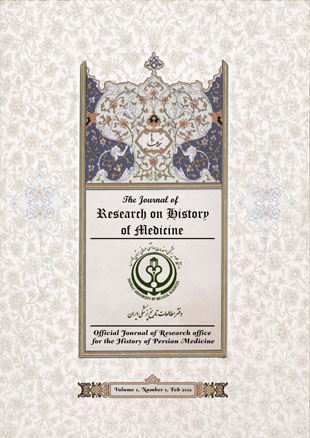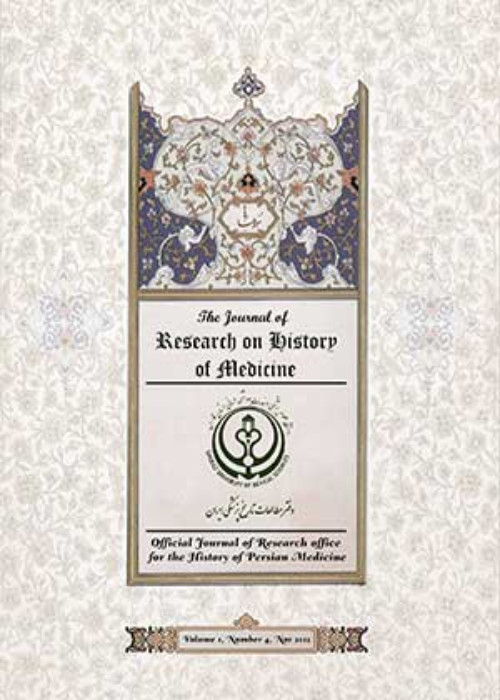فهرست مطالب

Journal of Research on History of Medicine
Volume:1 Issue: 1, Feb 2012
- تاریخ انتشار: 1391/01/20
- تعداد عناوین: 7
-
-
صفحه 9إن التراث الطبی الإسلامی مازال مصدرا اساسیا للدراسه التاریخیه الحضاریه فی نطاق توضیح الرویه فی التاریخ لفتره من الزمن غیر قصیره هی الفتره الحضاریه الإسلامیه فی صلاتها بالحضارات التی اثرت فی ها.
تزخر الحضاره الإسلامیه بنماذج متمیزه من النابغین النابهین فی کل فرع من فروع العلم والمعرفه، ویاتی الطب فی المقدمه من حیث التفوق فیه. یعد علم الطب من اوسع العلوم الحیاتیه التی کان لعلماء المسلمین دور بارز فی ها علی مدار عصور حضارتهم الزاهره و کانت إسهاماتهم غیر مسبوق شمولا و تمییزا و تصحیحا لمسار تاریخ الطب، حتی لیخیل للمطلع علی هذه الإسهامات الخالده کان لم یکن علم الطب قبل حضاره المسلمین. و لم تقتصر هذه الإسهامات علی الإبداع فی علاج الامراض فحسب بل تعداه إلی منهج تجریبی اصیل انعکست آثاره الراقیه و الرائعه علی کافه جوانب القضایا الطبیه وقایه و علاجا. إن جلاله هذه الإسهامات الإسلامیه فی الطب تتجلی فی تخرج الحشد الکثیر من العباقره الطبیه النادره التی کان لهم الفضل الکبیر فی حرکه الطب إلی التطور و الإبداع.
-
صفحه 11
جلوگیری از بارداری که امروزه یکی از بحث های مهم در حوزه زنان و زایمان به شمار می رود،از دیرباز یکی از دلمشغولی ها و نگرانی های زنان بوده است. چنان که در قدیمی ترین منابع پزشکی نیز نمود یافته است. که از آن جمله کتاب قانون ابن سینا به دلیل پیش رو نهادن راه های عملی در این زمینه همواره مورد توجه بوده است. از این رو در این مطالعه راه کارهای مورد اشاره توسط ابن سینا در کتاب قانون، به عنوان یکی از مهم ترین منابع سنتی تاریخ پزشکی مورد بررسی قرار می گیرد. هم چنین نوشتار حاضر علاوه بر آن که نشان دهنده ی دانش ایرانیان در این زمینه در قرون 10 و 11 میلادی است، امکانات بالقوه ای رادر راستای یافتن روش های جدید جلوگیری از بارداری برای مطالعه بیشتر در اختیار پژوهشگران طب نوین قرار می دهد.
کلیدواژگان: جلوگیری از بارداری، پزشکی ایرانی، ابن سینا، کتاب قانون در پزشکی -
صفحه 17ابوماهر/ ابوعمران موسی بن یوسف بن سیار ابن سیار شیرازی از پزشکان نامدار سرزمین فارس می باشد که در اواخر قرن سوم و اوایل قرن چهارمهجری می زیسته و با عده ای از پادشاهان دیلمی معاصر بوده است. مولف کتاب نامه دانشوران (دوره قاجار) درباره این طبیب چنین مینویسد: مبادی اشتهارش در صنایع طبیه با بدایت سلطان آل بویه مقارن بود و در روزگار استیلاء و اقتدار آن طبقه با احتشام و احترام به سر می برد. و در جای دیگر می گوید: «او به مقامی رسید که در زمان خویش شبیه و بدیلی نداشت و در زمره امثال و اقران عدیل و نظیرش نبود و هیچ یک از فضلای اطباء و دانشمندان حکما را نمیرسید که بر وی رتبه تقدم و مقام برتری جویند و جمعی از اطبای کامل و متمیزین این طبقه که در آن اوان به رتبه علم و مقام اعلی ارتقاء جستند، در نزد آن طبیب ماهر به تلمذ و استفادت مشغول بوده و از وی اخذ قوانین علمیه نموده اند.
-
صفحه 21تاریخ را به دشواری می توان تعریف کرد زیرا مفهومی است که به صور گوناگون به آن ارجاع داده می شود و می تواند ارزش ها، نظام های اعتقادی، هنجارها، معنا ها، شیوه های زندگی، نهادهای اجتماعی، رسوم و آداب، زبان و گفتمان، زیبا شناسی و هنر، و به طور کلی هویت یک ملت و یا در سطحی جهانی و عام، بشریت را در بر گیرد. با این حال مهم ترین شرط لازم برای ادراک تاریخ، ادراک زمان است که گذشته و حال و آینده را به صورت روندی مداوم و خطی به یکدیگر پیوند می زند و به جهت همین سیر خطی است که تاریخ از ساخت زمان دوری که اسطوره و حماسه را می سازد، متمایز می شود. روایت های تاریخی ابتدا به شکل نوشته های سنواتی و ثبت واقعیت های دوره ای بروز کرد که اهدافی کاملا عملی را دنبال می کردند. چنان که نوشته های معابد مصر باستان مشاهدات آسمانی و طغیان سالیانه ی نیل را که برای زندگی مردم و کشاورزی اهمیت حیاتی داشت، ثبت می کردند. در یونان باستان در حدود سده های هفتم و هشتم پیش از میلاد، تاریخ گستره ی بیشتری یافت و تلاش کرد تا مرزهای دورتری در گذشته را در بر گیرد. در پی همین گسترش معنایی تاریخ بود که یونانی ها توصیف منظم امر واقع را به محدوده ی تاریخ افزودند پس در دیدگاه ایشان تاریخ به طور کلی هرگونه توصیفی را شامل می شد. از این رو ارستو «تقریر منظم اطلاعات درباره ی پدیده های طبیعی» را تاریخ نامید و به عنوان نمونه جانورشناسی توصیفی را «تاریخ جانوران» نام داد. پس از ارستو این سنت ادامه یافت، چنان که تئوفراست شاگرد ارستو، گیاه شناسی توصیفی را «تاریخ نباتات» نامید.
-
Page 1Although there has been great progress in medical sciences, taking good care of human’s health and treatment of many of diseases satisfactorily are still out of reach. Regardless of having different understanding of the reasons and treatment methods, our new perspective of medical sciences, which is considered the result of the scientific renaissance in Europe in the 17th century by some and the result of Islamic Revolution in the 8th and 9th centuries by others, has not yet helped us to find cures for a lot of diseases.The theory of growing advances in the history of science which considers all the past efforts effective in the future achievements is not completely consistent with scientific methodology in which the issues related to the growth of science, making theories, principles and new scientific rules are discussed. From another aspect the dominant paradigm during each period of history gives the survival chance to the sentences which are solely consistent with the imposed paradigm framework. Anything inconsistent with the sole of that paradigm is victimized without any undeniable and clear reasons.
-
Page 3Although Iran has a deep history about 10000 years، its role in development of science in general and medicine in particular is yet to be known. There are several factors responsible for this، namely the destruction of a good number of ancient Persian manuscripts and books. Furthermore، lack of interest found among contemporary researchers seems to add to this anonymity. One way to compensate for this is to introduce scientific figures of the time. In this regard، Jamasp، as the great Persian scientist who lived about 500 BC، is introduced in this article. He was the minister of king Vishtasb and contemporary with Zoroaster. Though Jamasp is known as a great astronomer، physician، pharmacist، chemist and botanist by historians، he is a good candidate for the title “the father of Persian pharmacy”.Keywords: History of Pharmacy, Persia, Jamasp
-
Page 7Louis Hubert Farabeuf was born in Bannost (Sein-et-Marne) on May 6th 1841 and died in Beton-Bazoche (Aisne) in August 1910. He was Professor and Director of the Anatomical Department of the Faculty of Medicine in Paris until 1878. In 1879, he founded the School of Practical Studies in Paris, which contributed to anatomical studies. Farabeuf designed many surgical procedures. His manual of operatory surgery was published in 1893 and was well known. He described the triangle that is named after him and described it in hisPrécis de manuel opératoire, published in 1872. This triangle (Farabeuf’s triangle) is formed by the internal jugular vein, common facial vein and hypoglossal nerve. The jugulodigastric node can usually be found within the borders of this surgical triangle. In 1878, Farabeuf was named Head of Anatomical Studies a position that had been occupied by such great names as Dupuytren, Beclar, Curveilhier, Breschet, Denonvilliers, and Sappey.
-
Page 11
Throughout history، there have always been different opinions about the necessity and methods of contraception in different cultures. Persian medical scientists in the medieval era illustrated different contraceptive methods in their manuscripts. Avicenna، for example، discussed different types of contraceptive methods in Canon، one of the most important medical books written in the 10th century AD. In this paper، we describe the indications as well as two types of contraceptive methods derived from canon of Medicine: Physical & psychological methods and pharmacological Methods (Materia Medica). Reviewing such issues can not only present Avicenna’s professional and scientific knowledge but also help researchers in modern medicine to conduct experiments to find newer and more efficient prevention methods with fewer side effects.
Keywords: Contraception, Traditional Medicine, Avicenna, Canon of medicine -
Page 17Being contemporary with Avicenna and Rhazes, Abu Maher Shirazi was born in Shiraz the 10th century AD. He was known asthe first influential physician in Shiraz in the Islamic period and his students, such as Haly Abbas, called him a great scientist. Concerning his significant impact on medicine in this era, Abu Maher Shirazi is a good candidate for the title “the Founder ofShiraz Medical Doctrine”.


